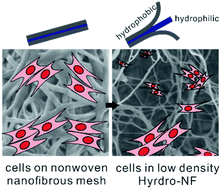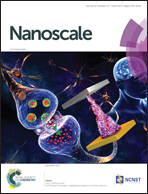Hydro-nanofibrous mesh deep cell penetration: a strategy based on peeling of electrospun coaxial nanofibers†
Abstract
A two-step strategy for coaxial electrospinning and postelectrospinning is an effective method for fabricating superfine nanofibers composed of highly swellable hydrogels. Alginate and poly(ε-caprolactone) [PCL] were coelectrospun via fibrous meshes with a coaxial nozzle; alginate at the core was subsequently cross-linked in calcium chloride solution. The PCL sheath was removed from the meshes by repeated organic-phase washing. The peeling process was monitored by scanning electron microscopy, transmission electron microscopy, and differential scanning calorimetry, and the complete removal of the PCL outer layers was confirmed by the thinning of the fiber volume. The obtained alginate hydronanofiber showed extreme water-swellability and mass erosion depending on the degree of cross-linking. We also measured the nanoscale and macroscale mechanical properties of a single nanofiber and of the whole mesh by atomic force microscopy and rheometry. Quantitative analysis of nanomechanical properties indicated that the hydronanofiber with higher cross-linking density had higher stiffness and Derjaguin–Müller–Toporov modulus. Cells laid on the mesh and the vertical infiltration distance were visualized and quantified by confocal laser scanning microscopy. Cells on the mesh with higher cross-linking density infiltrated deeply to the bottom of the mesh. Thus, hydrogel-like nanofibrous meshes are versatile matrices allowing for deep infiltration of cells throughout the mesh via manipulation of the mechanical properties of the nanofiber.



 Please wait while we load your content...
Please wait while we load your content...